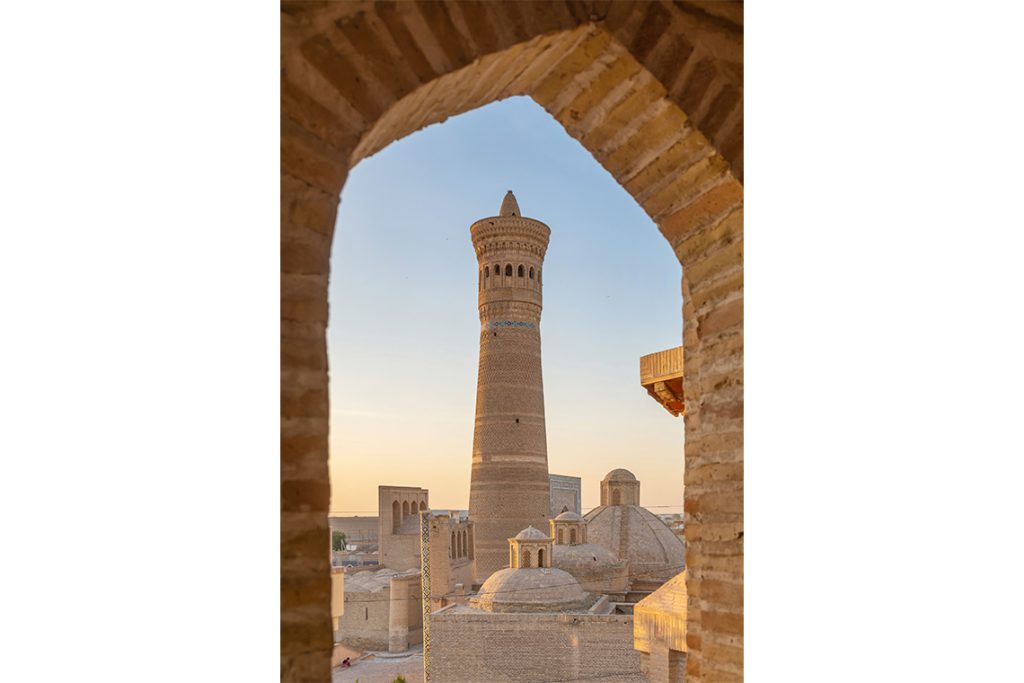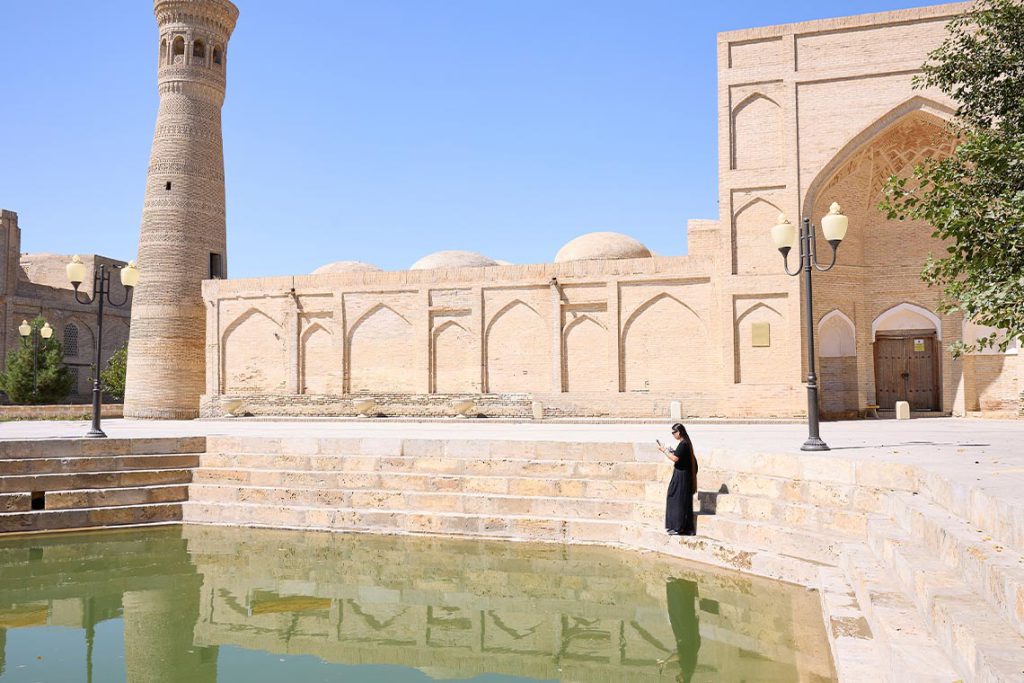The Chairperson of the Uzbekistan Art and Culture Development Foundation and commissioner of the Bukhara Biennial discusses leading the city-wide masterplan and her passion for reviving Uzbekistan’s art scene.
Canvas: The Uzbek art scene is undergoing a very clear revival. What makes it so special?
Gayane Umerova: In recent years, we’ve seen a real resurgence in the art scene, with contemporary artists making work that speaks to Uzbekistan’s rich history. One of our goals is to support this new generation of young artists as well as older generations and create opportunities for them to create and develop careers in the creative industries. An example is Oyjon Khayrullaeva. During Bukhara Biennial, the artist will present a project focused on ancestral knowledge about traditional remedies. Her work is highly contemporary yet remains firmly rooted in tradition as a celebration of her ancestral heritage. For me, it’s this coming together of centuries of heritage with a new energy that makes the Uzbek art scene special and something that we’re really championing with the Bukhara Biennial.
What makes now the right moment for Bukhara to hold a biennial?
Bukhara has been recognised by UNESCO and has had significance historically for several centuries. We are about to start a large conservation and revitalisation project across a historic district, as part of a city-wide masterplan. This year marks the first of a series of public facing events taking place with Uzbek craftspeople and international artists coming together and collaborating for the first time, something we’re deeply proud of.
Since the event was announced last September, the response has been overwhelmingly positive – from artists, curators and institutions – and it is clear that there is a real appetite to connect with our culture in a meaningful way.
The Bukhara Biennial embodies this vision, and will contribute to the country’s growing prominence internationally as a growing centre for contemporary art. It is the first event of its kind in Uzbekistan as well as Central Asia, and the first time our local crafts will be positioned in a contemporary context. More importantly, however, the event will create a platform for artists and artisans – to create work, to access more advanced infrastructure, to access contemporary art and to join the global cultural stage.
September will be a big moment culturally for Uzbekistan. Coinciding with the inaugural edition of the Bukhara Biennial, we will see the launch of the new Centre for Contemporary Arts (CCA) in Tashkent.

Uzbekistan has a rich, diverse cultural history, making it a dynamic place to launch an interdisciplinary biennial. What will set this biennial apart from others?
The event is part of a long-term project to give new purpose and access to historical landmarks, although the idea wasn’t to create a biennial in the traditional sense. Rather, it was to create a changing platform for Bukhara to reconnect its crafts and architectural heritage with the rest of the world. As commissioner, one of my first tasks was to find the curator for the first edition. In 2023, once we had established an overarching plan for the cultural district, I commissioned Diana Campbell, having seen and followed her work internationally for a number of years.
Staying true to our local traditions while opening the door to international voices is key for the foundation. This component of exchange, inspired by Bukhara’s history, is a real point of difference for the Bukhara Biennial, which seeks to build many forms of connections through art and culture. The event will be held across several newly restored landmarks and there will be a strong dialogue between the projects presented and Uzbekistan. It’s about honouring what’s always been here, while creating space for something new to grow.
The Uzbekistan Art and Culture Development Foundation (ACDF) is spearheading numerous initiatives. Can you tell us about them, as well as how the foundation became involved in launching the biennial?
The Bukhara Biennial is a very natural evolution of everything we have been working towards at ACDF – supporting artists, designers and craftspeople as they take their place on the global stage. The idea of hosting a biennial began with the need to think about how we activate our buildings today: how can we preserve them while also injecting a new lease of life, especially across buildings which have been closed for several years, vacant and inaccessible to the public? Another question which inspired the biennial was how do we keep our traditions alive and relevant today? That was the starting point and how the idea of a gathering – weaving two very distinct aspects of Bukhara’s identity, crafts with architecture – was developed.
The biennial will inaugurate newly restored historic buildings, enabling new spaces for culture to thrive within an evolving cultural district. which forms part of a much bigger masterplan for Bukhara prepared in cooperation with Wilmotte & Associés, Deloitte and other partners. Further plans include the new Centre for Contemporary Arts in Tashkent, as well as the new State Museum of Arts by Tadao Ando. Beyond Uzbekistan,further recent initiatives include commissioning the Uzbekistan Pavilion at the Venice Biennale Arte and Architettura since 2021, as well as Uzbekistan’s participation in Expo 2025 Osaka . These are all steps toward the same goal of building lasting spaces for dialogue, education, awareness and creativity.
Our continued commitment across the arts and culture in Uzbekistan and internationally is a priority for the government. This support has been instrumental to drive cultural initiatives forward, and in the development of contemporary initiatives, that help build global awareness of Uzbekistan’s cultural landscape, building an ecosystem where creativity thrives.
What drives your passion for advancing the Uzbek art scene?
My motivation to establish a sustainable art and cultural framework in Uzbekistan has been inspired by visits to museums from a young age. I remember being in awe of the various museums my mother would take me to, and they continue to inspire me to this day. We would also go to the theatre together. Her appreciation for the arts inspired me deeply. Having the opportunity to visit these cultural spaces, housing so much creative energy, has shaped who I am today and iand inspired me to become a curator and work across multiple creative industries, including Tashkent’s Navoi Theatre. I’m passionate about creating these spaces for future generations and, similarly, developing places where students, artists and children can interact and experiment with art on a day-to-day basis.
Alongside the large-scale architectural projects that I’ve mentioned, we are also working on the reconstruction of the State Children’s Library, a project that is really close to my heart. The library holds one of the largest collections of children’s books in Central Asia, with over 200,000 items. Rebuilding this crucial centre for children’s learning is especially important to me, and is part of this much broader project of making Uzbekistan a place full of potential and opportunities for future generations.

What does the Uzbek art scene offer to the global art discourse?
There is a very specific and strong connection between heritage and contemporary creativity in Uzbekistan. Interestingly, young generations are very interested in learning about their past, why particular events happened over the past century and what this means for them, including the exploration of their own identities. There is huge potential for collaboration and dialogue, where artists and artisans, tradition and innovation, can all come together in ways that feel exciting. The Bukhara Biennial will create a meeting point, inviting an international audience to see the thriving Uzbek art scene for themselves. We’re seeing more and more curiosity around Uzbekistan’s art scene, people are hungry for something authentic and I think that’s what we have here.
Are there misconceptions about the Uzbek art scene and cultural production?
There is a tendency to think that the Uzbek art scene is mostly focused on crafts and historic traditions and while this does form a crucial part of today’s creative industries, this is not the case. There is an incredible, strong contemporary art scene emerging, with promising young voices alongside more established artists. In the field of ceramics, ceramics master Abdulvahid Bukhoriy Karimov, whose work created in collaboration with Nada Debs features in Uzbekistan’s participation in Expo 2025 Osaka, as well as the renowned dynasty of ceramicists, the Rakhimov family – with Akbar Rakhimov, Alisher Rakhimov and Shokhrukh Rakhimov spanning three living generations (seven in total). The Bukhara Biennial will also showcase emerging photographers, such as Zilola Saidova and Hassan Kurbanbaev, who is gaining international recognition and has been shortlisted for the Paris Photo–Aperture PhotoBook Awards.
What springs to mind when you hear “Bukhara Biennial”? What does it mean for the future?
When I hear those words they bring me a huge sense of joy and pride in our culture. I think of centuries of history coming together for the first time. The Bukhara Biennial is really only the beginning – it’s part of a long-term journey that goes far beyond the 10-week event. Between each edition, there’ll be a programme of interventions and creative projects, so it’s something that will keep growing and evolving with time. The event marks the start of a bold new chapter for the city. Plans within the expanding district include spaces for artists to work, a digital archive, a fine art museum, a music school and a dedicated exhibition space. We see the biennial as the start of a process designed to reinvigorate the entire city.
How important is the city’s historic architecture to the biennial?
Preserving the architecture of Bukhara, a UNESCO Creative City of Crafts and Folk Art, is a mission we are proud to embark upon. As part of a permanent and evolving cultural district, each of the historic buildings activated by the biennial is being restored with care. The four caravanserais that serve as focal points during the biennial, as well as Gavkushon Madrasa, the former mosque Khoja Kalon and Rashid Madrasa, will all be carefully protected and enlivened beyond the biennial dates. These monumental historic buildings will be teeming with life again through year-round exhibitions, events and colourful interventions, forming an evolving epicentre in the heart of Bukhara, a place where culture can truly thrive. This long-term project is grounded in the belief that culture is a vital force for sustainable development, enriching not only the lives of artists and cultural practitioners but also nurturing the broader fabric of the city. It’s a vision rooted in longevity, and we are so excited to be making this long-term commitment to the region.
The inaugural Bukhara Biennial will run from 5 September to 20 November 2025



